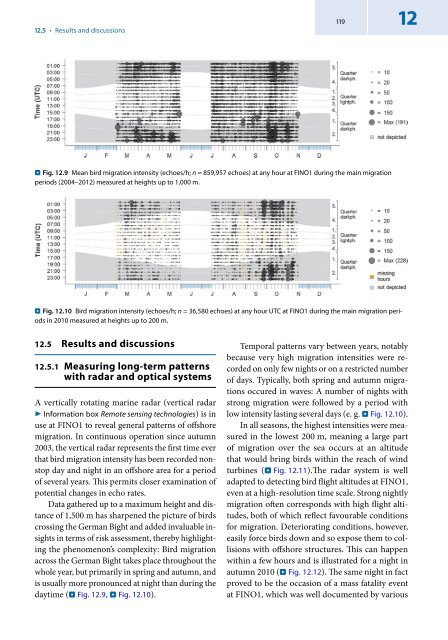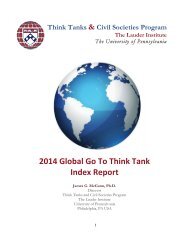bok%3A978-3-658-02462-8.pdf?auth66=1398409209_a0514c2b8e531c058ab8b810a0cad74d&ext=
bok%3A978-3-658-02462-8.pdf?auth66=1398409209_a0514c2b8e531c058ab8b810a0cad74d&ext=
bok%3A978-3-658-02462-8.pdf?auth66=1398409209_a0514c2b8e531c058ab8b810a0cad74d&ext=
- No tags were found...
You also want an ePaper? Increase the reach of your titles
YUMPU automatically turns print PDFs into web optimized ePapers that Google loves.
12.5 • Results and discussions119 12..Fig. 12.9 Mean bird migration intensity (echoes/h; n = 859,957 echoes) at any hour at FINO1 during the main migrationperiods (2004–2012) measured at heights up to 1,000 m...Fig. 12.10 Bird migration intensity (echoes/h; n = 36,580 echoes) at any hour UTC at FINO1 during the main migration periodsin 2010 measured at heights up to 200 m.12.5 Results and discussions12.5.1 Measuring long-term patternswith radar and optical systemsA vertically rotating marine radar (vertical radar▶ Information box Remote sensing technologies) is inuse at FINO1 to reveal general patterns of offshoremigration. In continuous operation since autumn2003, the vertical radar represents the first time everthat bird migration intensity has been recorded nonstopday and night in an offshore area for a periodof several years. This permits closer examination ofpotential changes in echo rates.Data gathered up to a maximum height and distanceof 1,500 m has sharpened the picture of birdscrossing the German Bight and added invaluable insightsin terms of risk assessment, thereby highlightingthe phenomenon’s complexity: Bird migrationacross the German Bight takes place throughout thewhole year, but primarily in spring and autumn, andis usually more pronounced at night than during thedaytime (. Fig. 12.9, . Fig. 12.10).Temporal patterns vary between years, notablybecause very high migration intensities were recordedon only few nights or on a restricted numberof days. Typically, both spring and autumn migrationsoccured in waves: A number of nights withstrong migration were followed by a period withlow intensity lasting several days (e. g. . Fig. 12.10).In all seasons, the highest intensities were measuredin the lowest 200 m, meaning a large partof migration over the sea occurs at an altitudethat would bring birds within the reach of windturbines (. Fig. 12.11).The radar system is welladapted to detecting bird flight altitudes at FINO1,even at a high-resolution time scale. Strong nightlymigration often corresponds with high flight altitudes,both of which reflect favourable conditionsfor migration. Deteriorating conditions, however,easily force birds down and so expose them to collisionswith offshore structures. This can happenwithin a few hours and is illustrated for a night inautumn 2010 (. Fig. 12.12). The same night in factproved to be the occasion of a mass fatality eventat FINO1, which was well documented by various




